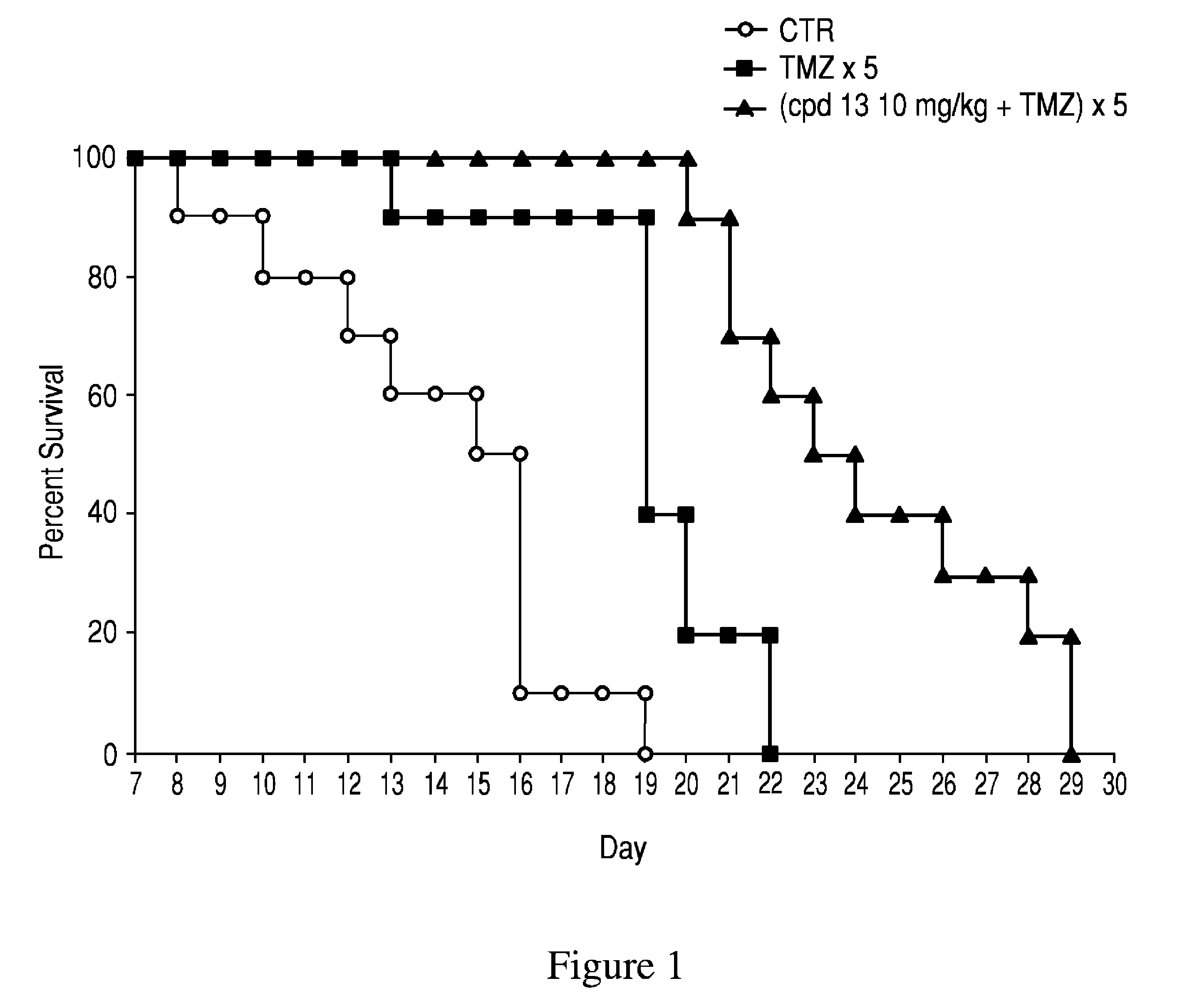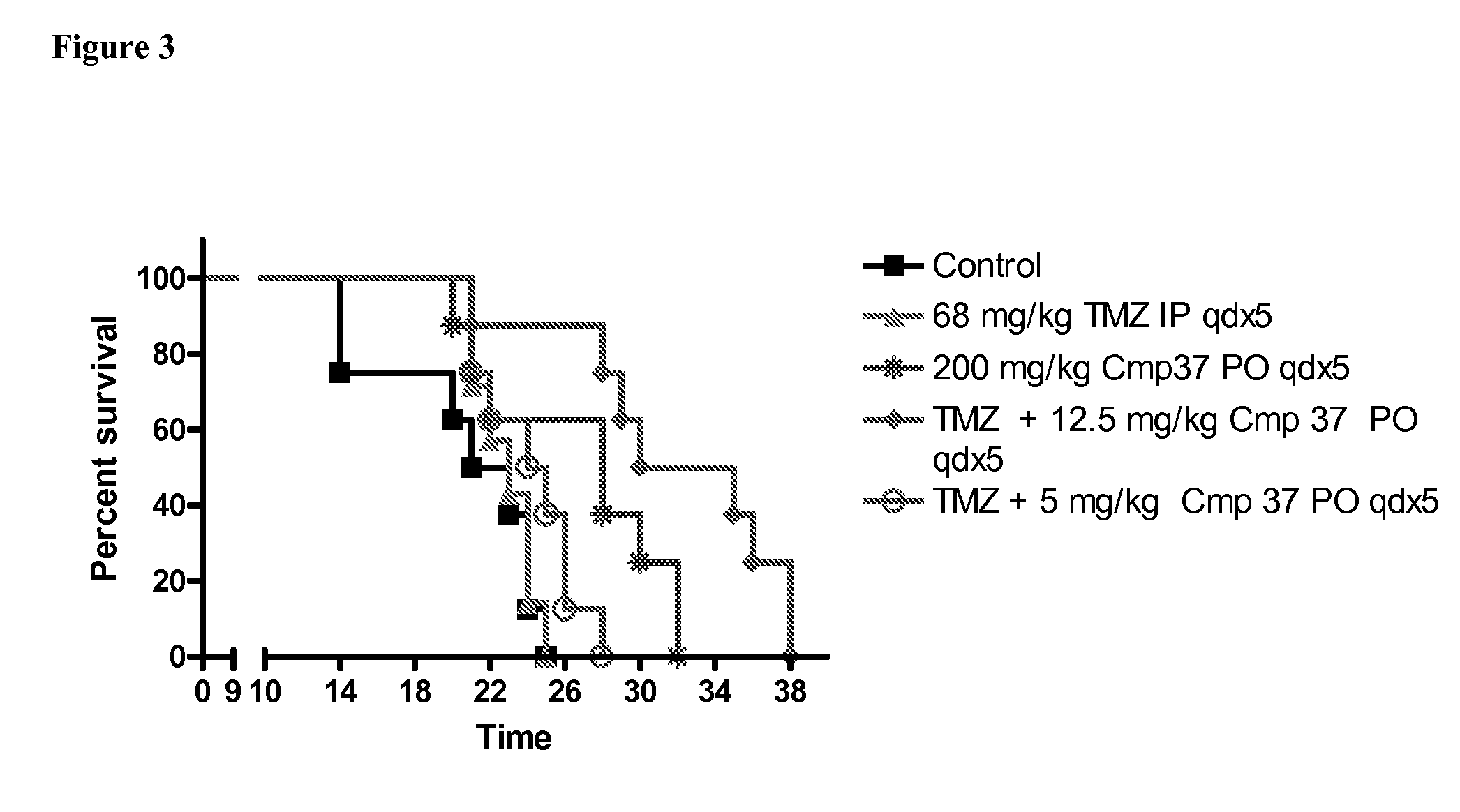PARP inhibitor compounds, compositions and methods of use
a technology of parp inhibitors and compounds, applied in the field of tetraaza phenalen3one compounds, can solve the problems of long period of regeneration required to restore function, limited effect of parp inhibitors, and ineffective use of parp inhibitors,
- Summary
- Abstract
- Description
- Claims
- Application Information
AI Technical Summary
Benefits of technology
Problems solved by technology
Method used
Image
Examples
example 1
Preparation of 8-(4-hydroxy-piperidin-1-ylmethyl)-2,9-dihydro-1,2,7,9-tetraaza-phenalen-3-one, 7
[0149]Following the General Procedure D: A solution of MeCN (25 ml), 4-hydroxypiperidine (0.46 mg, 4.5 mmol), 4 (1.0 g, 3.9 mmol), and potassium carbonate (1 g, 7 mmol) was set refluxing under nitrogen and stirred overnight. Reaction mixture was evaporated to dryness and extracted with dichloromethane. Purified with a silica column using 9:1 dichloromethane / MeOH to afford 1.05 g (84%) of an off-white solid, 2-(4-Hydroxy-piperidin-1-ylmethyl)-4-oxo-3,4-dihydro-quinazoline-5-carboxylic acid methyl ester, 7a.
[0150]Following the General Procedure E: To a solution of compound 7a (1.0 g, 3.1 mmol) in EtOH (20 mL) when refluxing was added hydrazine monohydrate (7 mL, large excess) and heated overnight. Reaction was cooled to RT and H2O (15 mL) was added resulting in a heavy white precipitate. Filtered and washed with 1:1 EtOH / H2O to afford 0.6 g (64%) of an analytically pure white solid, 7. MP: ...
example 2
Preparation of 8-[4-(4-methoxy-benzenesulfonyl)-piperazin-1-ylmethyl]-2,9-dihydro-1,2,7,9-tetraaza-phenalen-3-one, 50
[0201]To a stirring solution of 4 (2.2 g, 8.73 mmol, 1 eq) in 200 mL of acetonitrile was added piperazine (14 g, 0.162 mol, large excess) under a blanket of nitrogen. The solution was allowed to stir overnight and then evaporated to dryness. The crude material was purified via silica plug with 9:1 dichloromethane:methanol to afford 2.0 g of a fluffy white solid, 4-Oxo-2-piperazin-1-ylmethyl-3,4-dihydro-quinazoline-5-carboxylic acid methyl ester, 47A. MS (ES−): 301; 1H NMR (400 MHz, DMSO-d6): 2.40-2.43 (m, 4H), 2.69-2.72 (m, 4H), 3.41 (s, 2H), 3.83 (s, 3H), 7.44 (d, J=7.2 Hz, 1H), 7.74 (d, J=8.2 Hz, 1H), 7.82 (t, J=7.8 Hz, 1H).
[0202]To a stirring solution of 47A (170 mg, 0.56 mmol, 1 eq) in 5 mL of pyridine was added 4-methoxybenzene sulfonyl chloride (130 mg, 0.62 mmol, 1.1 eq) resulting in a bright yellow solution. The reaction was allowed to stir overnight and then ...
example 3
Preparation of (3-oxo-2,9-dihydro-3H-1,2,7,9-tetraaza-phenalen-8-ylmethyl)-carbamic Acid tert-butyl Ester, 69
[0223]Procedure H to prepare 2-aminomethyl-4-oxo-3,4-dihydro-quinazoline-5-carboxylic acid methyl ester, 67. To a solution of 25 mL of 7N NH3 (large excess) in MeOH at 0° C. was added compound 4 (1.0 g, 4.0 mmol) in a sealed tube. The mixture was then heated to 60° C. for 4 hours. The mixture was evaporated to dryness, dissolved and re-evaporated in 2×50 mL of CH2Cl2. Product was used as is without further purification.
[0224]Procedure I to prepare 2-(tert-butoxycarbonylamino-methyl)-4-oxo-3,4-dihydro-quinazoline-5-carboxylic acid methyl ester, 68. To a solution of 50 mL CH2Cl2 of with 2 mL of TEA (excess), catalytic DMAP and compound 67 (from Procedure H) was added boc anhydride (2.6 g, 3 eq) at room temperature. Reaction was allowed to stir for 60 minutes, during which time all solids went into solution. The solution was evaporated to dryness and purified via column chromato...
PUM
| Property | Measurement | Unit |
|---|---|---|
| concentrations | aaaaa | aaaaa |
| concentrations | aaaaa | aaaaa |
| volume | aaaaa | aaaaa |
Abstract
Description
Claims
Application Information
 Login to View More
Login to View More - R&D
- Intellectual Property
- Life Sciences
- Materials
- Tech Scout
- Unparalleled Data Quality
- Higher Quality Content
- 60% Fewer Hallucinations
Browse by: Latest US Patents, China's latest patents, Technical Efficacy Thesaurus, Application Domain, Technology Topic, Popular Technical Reports.
© 2025 PatSnap. All rights reserved.Legal|Privacy policy|Modern Slavery Act Transparency Statement|Sitemap|About US| Contact US: help@patsnap.com



